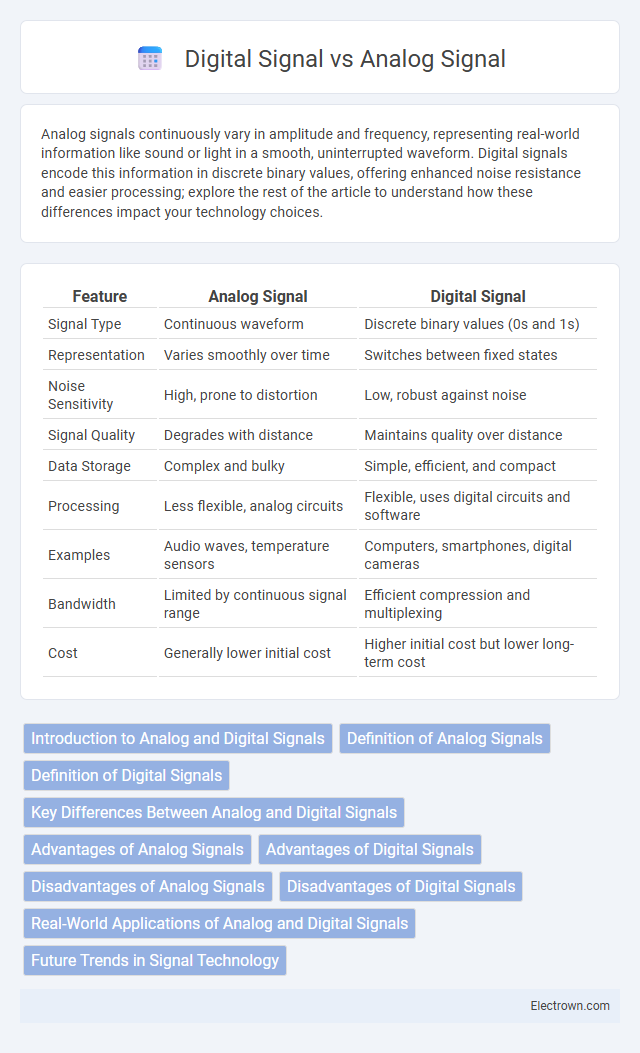Analog signals continuously vary in amplitude and frequency, representing real-world information like sound or light in a smooth, uninterrupted waveform. Digital signals encode this information in discrete binary values, offering enhanced noise resistance and easier processing; explore the rest of the article to understand how these differences impact your technology choices.
Table of Comparison
| Feature | Analog Signal | Digital Signal |
|---|---|---|
| Signal Type | Continuous waveform | Discrete binary values (0s and 1s) |
| Representation | Varies smoothly over time | Switches between fixed states |
| Noise Sensitivity | High, prone to distortion | Low, robust against noise |
| Signal Quality | Degrades with distance | Maintains quality over distance |
| Data Storage | Complex and bulky | Simple, efficient, and compact |
| Processing | Less flexible, analog circuits | Flexible, uses digital circuits and software |
| Examples | Audio waves, temperature sensors | Computers, smartphones, digital cameras |
| Bandwidth | Limited by continuous signal range | Efficient compression and multiplexing |
| Cost | Generally lower initial cost | Higher initial cost but lower long-term cost |
Introduction to Analog and Digital Signals
Analog signals represent continuous waveforms that vary smoothly over time, capturing real-world data such as sound or light in an infinite range of values. Digital signals use discrete binary values, typically 0s and 1s, to encode information for more reliable storage, processing, and transmission. Understanding the fundamental difference between analog's continuous nature and digital's discrete format helps you optimize signal processing techniques for various applications.
Definition of Analog Signals
Analog signals represent continuous variations of physical quantities such as sound, light, or temperature, characterized by infinite possible values within a range. These signals are typically modeled as sine waves with varying amplitude, frequency, or phase, allowing them to closely mimic real-world phenomena. Common examples include audio signals in microphones and video signals in traditional television broadcasts.
Definition of Digital Signals
Digital signals represent information using discrete values, typically binary code (0s and 1s), allowing for precise and noise-resistant data transmission. Unlike analog signals that vary continuously, digital signals maintain consistent voltage levels, ensuring better accuracy and easier error detection. Understanding digital signals is crucial for optimizing your communication systems and modern electronic devices.
Key Differences Between Analog and Digital Signals
Analog signals represent data through continuous waveforms that vary in amplitude and frequency, capturing real-world phenomena with infinite resolution. Digital signals encode information as discrete binary values, offering higher noise resistance, easier processing, and more efficient storage compared to analog signals. Understanding these key differences helps you select the appropriate signal type for applications requiring precision or robustness.
Advantages of Analog Signals
Analog signals offer superior representation of real-world phenomena due to their continuous nature, enabling smooth and natural variations in audio and video transmissions. They require simpler modulation and demodulation equipment, which often leads to lower cost and complexity in certain applications like traditional broadcasting and telephony. The ability to capture nuances and subtle changes results in higher fidelity for analog recordings compared to their digital counterparts.
Advantages of Digital Signals
Digital signals offer enhanced noise resistance and improved signal integrity, resulting in clearer and more reliable communication compared to analog signals. Their compatibility with modern digital devices enables efficient data compression, error detection, and correction, which boosts transmission accuracy. Furthermore, digital signals facilitate easier storage, processing, and encryption, making them ideal for contemporary telecommunications and computing systems.
Disadvantages of Analog Signals
Analog signals suffer from signal degradation and noise interference, which reduce transmission quality over long distances. These signals are less precise, making data storage and processing less efficient compared to digital signals. Your communication system may experience distortion and limited bandwidth due to the inherent limitations of analog technology.
Disadvantages of Digital Signals
Digital signals suffer from quantization errors and limited resolution, which can degrade signal accuracy and fidelity. They require complex encoding and decoding processes, leading to increased system complexity and processing power. Susceptibility to data loss and timing errors during transmission can also compromise signal integrity in digital communication systems.
Real-World Applications of Analog and Digital Signals
Analog signals are widely used in audio and video broadcasting, telecommunications, and sensor technologies due to their continuous nature, enabling precise representation of real-world phenomena such as sound waves and temperature variations. Digital signals dominate computing, data transmission, and modern communication systems like the internet and mobile networks, offering noise resistance and efficient data processing through discrete binary values. Hybrid systems often combine both signals to leverage analog's fidelity and digital's reliability in applications like medical imaging and instrumentation.
Future Trends in Signal Technology
Future trends in signal technology indicate a significant shift from analog to digital signals, driven by advancements in integrated circuits and machine learning algorithms that enhance signal processing accuracy and efficiency. Emerging technologies such as 5G and IoT heavily rely on digital signals for faster data transmission, improved noise resistance, and scalability in communication networks. Quantum computing and software-defined radio further revolutionize signal modulation and decoding, promising more adaptive and secure digital signal frameworks in the coming decade.
Analog signal vs Digital signal Infographic

 electrown.com
electrown.com